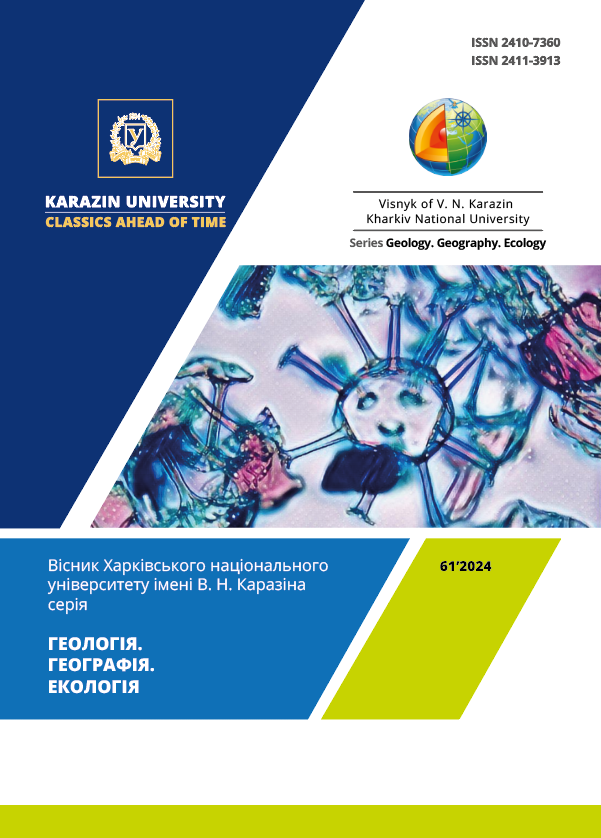Urban integration of forced migrants: lessons from Canada and Ukraine
Abstract
Statement of the problem. Active hostilities began in Ukraine, leading to the imposition of a state of war in the country on 24 February 2022. This has resulted in a mass displacement, with citizens leaving their homes in search of safety and protection. Currently, 3.6 million people have left Ukraine, while 6.5 million people are internally displaced. These unprecedented migration flows have created immense challenges for both the displaced populations and the host communities that strive to accommodate them. In the face of extraordinary challenges, Canada was one of the first countries to come to Ukraine's aid. The Canadian government facilitated the visa process for Ukrainians, allowing them to migrate to Canada.
The aim of the work is to analyze and evaluate the impact of migrants on urban development, focusing on the cases of Ukraine and Canada.
Methods. In the course of the research and preparation of the article, the author used methods of analysis and synthesis, comparative-geographical and comparative-historical approaches, as well as the method of generalization.
Results. This article delves into two critical aspects of Ukrainian migration during the ongoing war: internal displacement within Ukraine and international migration to Canada. We analyze the settlement patterns of migrants and the pressure they exert on cities. The geographical distribution is diverse. IDPs settle both in cities near the frontlines and in western regions in Ukraine. Despite all the risks, Kyiv the capital city of Ukraine, remains highly attractive. When relocating to Canada, migrants are guided by two factors: either having acquaintances, relatives, or friends already living there, or simply choosing a well-known large city. As research indicates, various sectors of urban infrastructure and services face challenges and opportunities under the influence of migration. Canada demonstrates effective integration through its well-developed laws, inclusive policies, and support systems that protect migrants' rights, fight discrimination, and provide essential services. The Ukrainian diaspora plays a significant role in this process by helping newcomers adapt. Ukraine's experience with internal migration caused by armed conflict shows the country's challenges in managing large-scale resettlement. The lack of housing, jobs, and social services pushed local authorities to respond quickly to the situation and learn from the practices of other countries. Our analysis underscores the need for strategic planning and investment to ensure sustainable urban development in the face of large-scale migration. Understanding the implications of these movements is essential for building resilient communities and addressing the complex challenges posed by displacement.
The novelty. For the first time, the readiness of Canadian and Ukrainian cities to accommodate migrants was compared. Furthermore, the study analyzed how various sectors of urban infrastructure and services adapt to challenges and take advantage of opportunities created by migration.
Downloads
References
Brettell, C. B. (2000). Urban History, Urban Anthropology, and the Study of Migrants in Cities. City & Society, 12(2), 129–138. DOI: https://doi.org/10.1525/city.2000.12.2.129
Çaglar, A., & Glick Schiller, N. (2018). Migrants and City-Making: Dispossession, Displacement, and Urban Regeneration. Duke University Press. https://library.oapen.org/handle/20.500.12657/25763
Gilmartin, M. (2008). Migration, Identity and Belonging. Geography Compass, 2(6), 1837–1852. DOI: https://doi.org/10.1111/j.1749-8198.2008.00162.x
Hou, F., & Yan, X. (2020). Immigrants from Post-Soviet States: Socioeconomic Characteristics and Integration Outcomes in Canada. Migration from the Newly Independent States: 25 Years After the Collapse of the USSR. Springer Interna-tional Publishing, 373–391. DOI: https://doi.org/10.1007/978-3-030-36075-7_17
Huang, X., & Liu, C. Y. (2018). Welcoming Cities: Immigration Policy at the Local Government Level. Urban Affairs Review, 54(1), 3–32. DOI: https://doi.org/10.1177/1078087416678999
Hudson, G. (2019). City of hope, city of fear: Sanctuary and security in Toronto, Canada. В Sanctuary cities and urban struggles. Manchester University Press. https://www.manchesterhive.com/display/9781526134929/9781526134929.00010.xml
Immigration Refugees and Citizenship Canada (2020). Immigration, Refugees and Citizenship Canada. https://www.canada.ca/en/immigration-refugees-citizenship.html
IOM Ukraine. (2022). https://ukraine.iom.int/uk/dani-ta-resursy
Kilian, L., & Zhou, X. (2022). The Propagation of Regional Shocks in Housing Markets: Evidence from Oil Price Shocks in Canada. Journal of Money, Credit and Banking, 54(4), 953–987. DOI: https://doi.org/10.1111/jmcb.12847
Liliana Filipchuk, O. S. (2022). Forced migration and war in Ukraine (March 24—June 10, 2022). Cedos. https://cedos.org.ua/researches/vymushena-migracziya-i-vijna-v-ukrayini-24-bereznya-10-chervnya-2022/
Newbold, K. B. (2011). Migration Up and Down Canada’s Urban Hierarchy. Canadian Journal of Urban Research, 20(1), 131–149.
Niemets, K., Sehida, K., Niemets, L., Kravchenko, K., Kobylin, P., Telebienieva, I., Kliuchko, L. (2022). Methodology of human-geographical researches: contemporary approaches and methods. Visnyk of V. N. Karazin Kharkiv National University, Series "Geology. Geography. Ecology", (56), 143-158. https://doi.org/10.26565/2410-7360-2022-56-10
Olena Syrbu. (2022). Returning IDPs and Refugees: What Influences Decisions. Cedos. https://cedos.org.ua/researches/povernennya-pereselen_ok-i-bizhen_ok-shho-vplyvaye-na-rishennya/
Pottie-Sherman, Y. (2020). Rust and reinvention: Im/migration and urban change in the American Rust Belt. Geography Compass, 14(3), e12482. DOI: https://doi.org/10.1111/gec3.12482
Pottie-Sherman, Y., & Graham, N. (2021). Live, Work, and Stay? Geographies of Immigrant Receptivity in Atlantic Canada’s Aspiring Gateways. Geographical Review, 111(2), 287–307. DOI: https://doi.org/10.1080/00167428.2020.1804301
Rehaag, S. (2008). Patrolling the Borders of Sexual Orientation: Bisexual Refugee Claims in Canada. McGill Law Journal, 53(1), 59–102.
Romão, J., Kourtit, K., Neuts, B., & Nijkamp, P. (2018). The smart city as a common place for tourists and residents: A structural analysis of the determinants of urban attractiveness. Cities, 78, 67–75. DOI: https://doi.org/10.1016/j.cities.2017.11.007
Sehida K., Niemets L., Husieva N., Suptelo O., Kobylin P., Kliuchko L. (2018). Migration Challenges of the 21st Century: The Experience of Ukraine. The International Business Information Management Conference (32nd IBIMA) (Seville, Spain, 15-16 November, 2018), 328-337.
Teofil Randyuk. (2022). Forced migration in the conditions of the Russian-Ukrainian war and its negative consequences for the gene pool of Ukraine. http://www.nas.gov.ua:80/UA/Messages/Pages/View.aspx?MessageID=9149
Ukrainian World Congress. (2022). Ukrainians in Canada: From the first wave of immigration to now - Ukrainian World Congress. https://www.ukrainianworldcongress.org/ukrainians-in-canada-from-the-first-wave-of-immigration-to-now/
Yuriy Umansky. (2023, апрель 28). Canada is facing the largest wave of Ukrainian immigration ever. New Canadian Media. https://newcanadianmedia.ca/many-ukrainians-have-applied-for-a-visa-to-come-to-canada-but-many-of-them-choose-not-to-come/

This work is licensed under a Creative Commons Attribution 4.0 International License.





